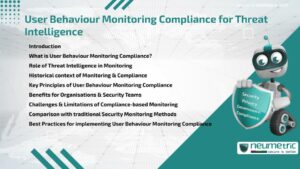Table of Contents
ToggleIntroduction
User Behaviour Monitoring Compliance is an essential part of modern Cybersecurity Strategies. It refers to the Lawful & Ethical tracking of User activities within an organisation to detect anomalies & prevent Threats. By aligning monitoring practices with Compliance Requirements, Organisations enhance their Threat Intelligence capabilities while protecting Employee Privacy. This balance ensures that monitoring strengthens defenses without violating Legal or Ethical Standards. The approach is widely used to identify insider Threats, detect abnormal Access patterns & prevent data Breaches before they escalate.
What is User Behaviour Monitoring Compliance?
User Behaviour Monitoring Compliance ensures that Organisations track & analyse User activity in line with legal, regulatory & ethical obligations. It involves defining clear Policies, applying Security Controls & documenting processes to meet standards such as the General Data Protection Regulation [GDPR], the Health Insurance Portability & Accountability Act [HIPAA] & other Data Protection frameworks. Compliance ensures that the use of monitoring technologies is justified, transparent & respects User rights while serving organisational security needs.
Role of Threat Intelligence in Monitoring
Threat Intelligence transforms raw monitoring data into actionable insights. By combining monitoring Compliance with intelligence tools, Organisations can:
- Detect suspicious patterns in User activity.
- Identify potential insider Threats.
- Correlate User behavior with external Threat indicators.
- Anticipate & mitigate Risks before they impact critical systems.
In this way, user behaviour monitoring Compliance serves as a foundation for more effective & targeted Threat Intelligence programs.
Historical context of Monitoring & Compliance
Monitoring of Employee activity is not new. Organisations have historically tracked emails, internet usage & system logs to enforce Policies. However, early practices often lacked Transparency & raised Privacy concerns. Over time, Regulatory Frameworks evolved to safeguard User rights. Laws such as GDPR emphasised Lawful Purpose, Proportionality & Accountability. This shift transformed monitoring from a purely technical process into a Compliance-driven responsibility. Today, organisations must not only monitor but also justify, document & protect how monitoring data is collected & used.
Key Principles of User Behaviour Monitoring Compliance
Successful monitoring Compliance relies on several principles:
- Lawfulness: Monitoring must comply with applicable legal frameworks.
- Transparency: Users should be informed about the extent & purpose of monitoring.
- Proportionality: Monitoring must be limited to what is necessary for security.
- Data Protection: Collected data must be secured & used responsibly.
- Accountability: Organisations must document & demonstrate Compliance.
These principles create a balanced Framework that protects both organisational interests & User rights.
Benefits for Organisations & Security Teams
Adopting User Behaviour Monitoring Compliance provides clear advantages:
- Improved Threat detection: Identifies anomalies that traditional tools may miss.
- Enhanced insider Risk Management: Protects against intentional or accidental misuse of systems.
- Regulatory alignment: Demonstrates adherence to Data Protection & Privacy laws.
- Operational efficiency: Streamlines investigations by providing structured insights.
- Trust & transparency: Builds stronger relationships with Employees & Stakeholders.
Challenges & Limitations of Compliance-based Monitoring
Despite its benefits, Compliance-driven monitoring faces obstacles:
- Privacy concerns: Employees may feel their Privacy is compromised.
- Resource demands: Implementing compliant monitoring can be costly & complex.
- Data overload: Large volumes of activity logs can overwhelm security teams.
- Balancing oversight with trust: Over-monitoring can harm organisational culture.
Recognising these limitations is crucial to designing a program that delivers security without eroding Employee confidence.
Comparison with traditional Security Monitoring Methods
Traditional Security Monitoring often focuses on system performance, malware detection or perimeter defenses. User Behaviour Monitoring Compliance, in contrast, emphasises human actions & their context. An analogy is comparing airport baggage scanners to behavioral profiling: while scanners detect prohibited items, profiling identifies unusual passenger behavior that may indicate hidden Risks. Together, these approaches create a layered & more comprehensive defense strategy.
Best Practices for implementing User Behaviour Monitoring Compliance
To implement effective monitoring Compliance, Organisations should:
- Define clear monitoring Policies aligned with Legal frameworks.
- Inform & educate Employees about monitoring practices.
- Use advanced analytics & machine learning to identify anomalies.
- Limit monitoring scope to relevant activities to ensure proportionality.
- Regularly Audit monitoring practices to maintain Accountability.
- Integrate monitoring insights with broader Threat Intelligence systems.
Following these Best Practices ensures monitoring remains ethical, lawful & effective.
Takeaways
- User Behaviour Monitoring Compliance balances Security & Legal obligations.
- It enhances Threat Intelligence by turning activity data into actionable insights.
- Core Principles include Lawfulness, Transparency, Proportionality & Accountability.
- Benefits include improved detection, insider Risk Management & Regulatory alignment.
- Challenges involve Privacy, resource demands & cultural impacts.
- Effective programs combine monitoring with education, analytics & oversight.
FAQ
What is User Behaviour Monitoring Compliance?
It is the lawful & ethical tracking of User activity to detect Threats while adhering to Privacy & Compliance standards.
How does Compliance improve Threat Intelligence?
By ensuring data collection is lawful & accurate, Compliance provides trustworthy inputs for Threat Intelligence analysis.
What are the key principles of monitoring compliance?
Principles include Lawfulness, Transparency, Proportionality, Data Protection & Accountability.
Why do Organisations need User Behaviour Monitoring?
It helps detect insider Threats, unusual Patterns & potential Breaches that traditional monitoring may miss.
What are the Risks of non-compliant monitoring?
Risks include legal penalties, reputational damage & loss of Employee trust.
Does monitoring Compliance replace traditional Security Measures?
No, it complements them by focusing on human actions while traditional tools monitor systems & networks.
How can Organisations maintain Employee trust while monitoring?
By being transparent, limiting monitoring to necessary activities & protecting collected data.
Need help for Security, Privacy, Governance & VAPT?
Neumetric provides organisations the necessary help to achieve their Cybersecurity, Compliance, Governance, Privacy, Certifications & Pentesting needs.
Organisations & Businesses, specifically those which provide SaaS & AI Solutions in the Fintech, BFSI & other regulated sectors, usually need a Cybersecurity Partner for meeting & maintaining the ongoing Security & Privacy needs & requirements of their Enterprise Clients & Privacy conscious Customers.
SOC 2, ISO 27001, ISO 42001, NIST, HIPAA, HECVAT, EU GDPR are some of the Frameworks that are served by Fusion – a SaaS, multimodular, multitenant, centralised, automated, Cybersecurity & Compliance Management system.
Neumetric also provides Expert Services for technical security which covers VAPT for Web Applications, APIs, iOS & Android Mobile Apps, Security Testing for AWS & other Cloud Environments & Cloud Infrastructure & other similar scopes.
Reach out to us by Email or filling out the Contact Form…





